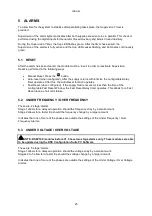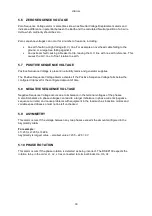
Alarms
29
5.5.7 R.O.C.O.F.
Indicates that the Rate of Change of Frequency (R.O.C.O.F.) is greater than the configured settings of
the R.O.C.O.F. alarm for more than the configured time.
R.O.C.O.F. detection of ‘mains failure when in parallel’ relies upon the relative steady state of the
utility power grid frequency. Normally supplied by a myriad of large power generating stations, the
frequency cannot normally change quickly over a short period of time.
A failure of the utility supply usually leads to sudden increase or decrease in the active load of the
local generator and a subsequent drop or rise in its frequency. This is detected by the R.O.C.O.F.
alarm.
The frequency of the AC supply is monitored and filtered over the configured number of voltage
cycles. If the frequency has changed by more than the configured amount for more than the
configured time the alarm is activated.
5.5.7.1
EXAMPLE OF ROCOF (FREQUENCY DIP UPON MAINS FAILURE)
In this example, the generator is in parallel with the mains supply, with the mains supplying the
majority of the load.
Upon the mains failure event, the frequency of the generator decreases due to the extra load being
applied. This is measured over the configured number of cycles to give a Rate Of Change Of
Frequency (Hz/s). If this value remains above the configured trip point for longer than the configured
delay time, a R.O.C.O.F. trip is generated.
Generator output frequency dips and
recovers upon mains failure when in
parallel as the generator load increases.
R.O.C.O.F. (df/dt)
Rate of Change Of Frequency (Hz/s)
Time
Frequency
Hz
s
Time of mains failure
event














































